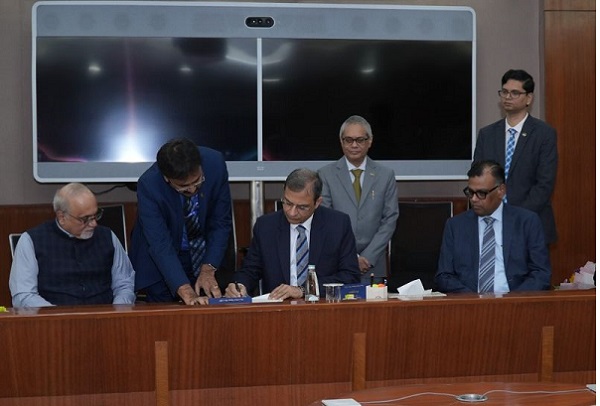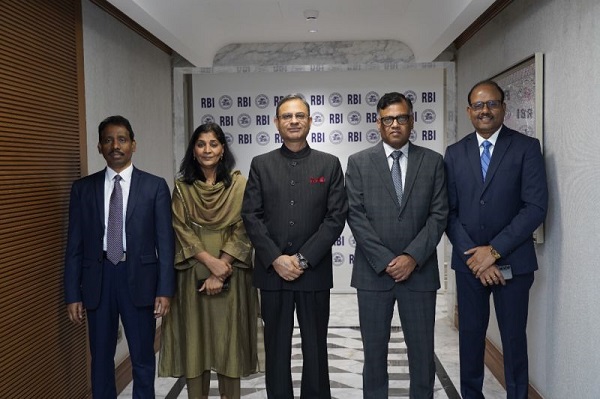.png)
Inside HDFC Bank’s Risk Playbook: Parthasarthy Breaks It Down
From 2008 to today, Ashish Parthasarthy has shaped how India manages risk. The HDFC Bank treasury head opens up in this sharp Q&A.

July 19, 2025 at 7:06 AM IST
As Group Head of Treasury at HDFC Bank, Ashish Parthasarthy oversees more than just market operations. His portfolio spans treasury, infrastructure, digital channels and branch banking, making him a key voice in shaping the bank’s financial architecture. A board member of FIMMDA, Parthasarthy is also among the last few from the bank’s founding team still in an executive role.
In this conversation with market veteran Manoj Rane, he lays out how HDFC Bank’s early institutional choices have helped it avoid pitfalls that have tripped up others. At the centre of this discipline is a structural separation between risk-taking and risk-approving teams, something Parthasarthy says was borrowed consciously from the multinational bank playbook and embedded from day one.
Looking back at the 2008 derivatives crisis, he attributes HDFC Bank’s relatively unscathed position to five principles: customer suitability, economic exposure, ability to absorb losses, pricing discipline and clear documentation. “What courts look at is not just documentation but conduct and intent,” he notes.
On the much-discussed Credit Support Annexes, or CSAs, Parthasarthy offers a contrarian view. While widely seen as a risk mitigation tool, he argues they are largely unworkable for borrowing corporates in India. “If a customer is already borrowing, where is the liquidity to post daily collateral in foreign currency?” he asks. CSAs, he believes, make sense for cash-rich clients but not for the vast majority of hedging users.
He also explains how HDFC Bank’s approach to internal hedging differs from some peers. Every accounting hedge is backed by a market trade and directly tagged to the underlying liability. There are no internal offsetting deals or assumptions of economic equivalence. That clarity, he says, reduces scope for interpretation and avoids accounting surprises.
Parthasarthy also shares his views on the bond market, where he sees value at the long end, driven by strong structural demand and fiscal discipline. He expects the rupee’s depreciation to moderate to around 2% annually, citing macro stability and narrowing inflation differentials.
What emerges is a view shaped by deep operational experience, with clear signals for market participants and regulators alike. The conversation also underscores the importance of transparency and consistency over sophistication when it comes to managing financial risk.
Read on:
Q: HDFC Bank navigated the 2008 derivatives crisis with remarkable discipline. What made that possible?
A: A lot of it goes back to how we set up the bank from day one. One of the most critical principles we borrowed from our multinational banking experience was the strict separation of duties. The teams that originated or took on risk—be it market or credit—were entirely distinct from the teams that approved or monitored that risk. That meant market risk, credit risk, front office, mid office, and back office were not only functionally separate but also reported independently, converging only at the level of the MD and CEO. This structure allowed us to build checks and balances that were culturally ingrained, not just process-driven.
When the 2008 derivatives crisis hit, many banks found themselves exposed to clients who either didn’t understand the products or couldn’t absorb the potential losses. At HDFC Bank, we applied a basic but robust framework. First, we evaluated whether the customer genuinely understood the risks. Second, we assessed whether they had the financial wherewithal to withstand a loss. Third, we ensured there was a legitimate underlying exposure—economic, if not accounting—that justified the hedge. Finally, we tried to ensure our own benefit from any deal was not disproportionate to the value it created for the client. We were clear that if the bank earned too much upfront, it meant the customer was likely taking on risk they didn’t fully grasp.
Even with documentation in place, what ultimately matters—especially in litigation—is intent. Courts don’t only look at contracts; they look at conduct. Thanks to this discipline, our disputes were few and manageable, even during a crisis that saw others significantly impacted.
Q: You were early adopters of Credit Support Annexes. Did they help?
A: We were among the first domestic banks to explore CSAs, especially in interbank transactions where they’re better understood. But when it came to corporates, the success was limited. The concept is sound—collateral mitigates counterparty credit risk—but in practice, CSAs often create more strain than safety in the Indian context.
Here’s why. Most corporate derivative users in India are borrowers. They’re entering swaps or forwards to hedge their liabilities—interest rates or foreign currency exposure—not to enhance yield on surplus funds. If you then require them to post daily variation margin, often in foreign currency and cash, where are they supposed to get that from? You’re adding liquidity stress on top of debt obligations.
CSAs make sense for cash-rich clients or those running treasury operations akin to asset managers. But for leveraged corporates, they complicate the risk landscape. In our view, the better safeguard is rigorous credit evaluation, clear documentation, and constant monitoring—not a collateral framework that the client can’t sustain. Collateral should support risk management, not create default risk by itself.
Q: Internal hedge accounting failures have caused concern in some banks. What does HDFC Bank do differently?
A: We’ve consciously chosen the simplest and most transparent route. At HDFC Bank, any accounting hedge—say, for a foreign currency borrowing—is backed by a specific, externally executed market transaction. That transaction is tagged directly to the underlying exposure and accounted for in a separate book. There’s no internal mirroring or offsetting deal between the ALM book and the trading desk. That reduces ambiguity and limits the potential for misinterpretation or misstatement.
Any deal that isn’t part of this accounting hedge book is treated as a trading position and marked to market accordingly. This binary classification keeps things clean. The minute you start layering internal deals or assumptions about economic hedges, you open the door to accounting complexity. Even worse, you create scope for inconsistent interpretations between internal stakeholders and auditors.
We also involve all control functions—front office, market risk, mid office, accounting—in the design and vetting of any new process. Every vertical understands how a transaction will be booked, how it will reflect in the financials, and how it will be monitored. If everyone does their part, and the lines of accountability are clear, there’s little room for surprises. Of course, mistakes can still happen, but intent and process integrity are your best safeguards.
Q: With the rate curve steepening, is there still value in long bonds?
A: Yes, I believe so—especially when you consider structural demand and fiscal discipline. The curve has steepened after the rate cuts, and the market seems to think the window for further cuts is narrow. But I don’t agree with that conclusion entirely.
If you look closely, there are still pockets of disinflation. Global supply chains remain under pressure, and geopolitical disruptions are weighing on demand. India’s credit growth has also slowed meaningfully, which could drag down GDP growth. That creates room—maybe not in the next policy, but certainly over the next year—for more easing.
More importantly, the demand-supply equation in the government bond market is very favourable. On the supply side, the Centre’s commitment to fiscal consolidation has kept net issuance disciplined, especially as a share of GDP. On the demand side, you’re seeing a demographic-driven expansion in long-term savings—from EPFO, NPS, insurance companies. These are structural pools of demand that are only growing.
So when you combine low net supply, steady demand, and macro stability, it points to enduring value at the long end. We could remain in a low-rate regime longer than the market expects.
Q: What is your view on the rupee’s direction over the next few years?
A: The rupee has historically depreciated by about 3–4% per year, which broadly reflects India’s inflation differential with developed economies. But I think we’re entering a new phase where that rate of depreciation will moderate.
First, India’s inflation is now far more controlled—between 4 and 5%—compared to the high double digits we used to live with. Meanwhile, developed markets are managing inflation around 2%, give or take. That narrows the inflation differential to 2–2.5%, and over time, that should reflect in currency trends.
Second, our current account has been relatively stable. We’re not facing runaway trade deficits, and even with volatile capital flows, the macro framework is far stronger than it was a decade ago.
Put all that together, and I see the rupee depreciating more gradually—closer to 2% a year—rather than the historic 3.5 or 4%. It will still move in steps, often triggered by global shocks or domestic sentiment, but those steps will be smaller and less disruptive.
Q: Any final message for investors or market participants?
A: The most important thing in any market is to be clear about your objective. Why are you taking a position? Is it for long-term investment, short-term speculation, or liability management? That clarity determines everything—how much risk you take, how you react to volatility, what metrics you track, even when you choose to exit.
One of the most common mistakes I’ve seen is people changing their objective mid-way—usually to justify a loss. A trade goes bad, and suddenly it becomes a “long-term investment.” That’s not strategy; that’s avoidance.
If you’re investing for the long term, you must accept that some years will be down. If you’re trading, you must be disciplined enough to book a loss when the rationale breaks down. The biggest damage happens when people confuse the two.
So have a clear objective, and stay true to it. Everything else flows from there.
Other Market Makers Interviews
-
B Prasanna on RBI Rate Cuts, Rupee Stability & Why the US Dollar Is Losing Its Mojo
-
Rupee, Rates, and Reforms: Nilesh Shah on India’s Market Shift
-
Axis Bank’s Neeraj Gambhir on Bond Market, RBI Policy and FX Outlook
-
Risk Management, Rates and Markets with HDFC Bank's Ashish Parthasarthy



